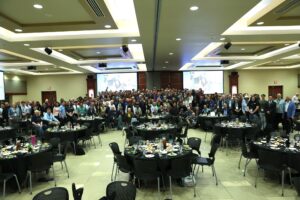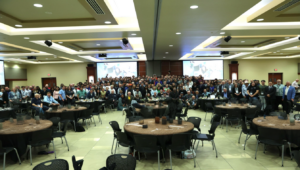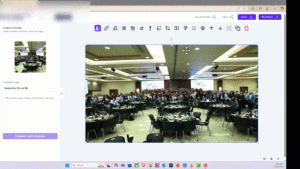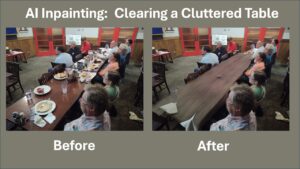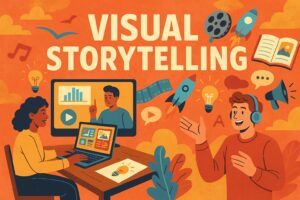Cool Science
IEEE and Cool Science Collaboration
This mini website will focus on the informal collaboration activities between the IEEE Pikes Peak Section and Cool Science that originated in Colorado Springs.
Exciting Collaboration Between IEEE Pikes Peak Section and Cool Science
Recently, Mark Heinrich, Secretary Officer of the IEEE Pikes Peak Section (PPS), took proactive steps to ensure a fruitful collaboration between the IEEE PPS and Cool Science. During a STEAM-TEAMS meeting on February 11, 2025, organized by Dr. John Santiago, Mark seized the opportunity to connect with Marc Straub, the Executive Director of Cool Science. This strategic meeting, held on March 10, 2025, at Village Inn, was a pivotal moment for both organizations.
At the meeting, Marc Straub introduced Cool Science and highlighted the upcoming Cool Science Festival scheduled from September 27 to October 12 as well as the monthly meetings ‘Science on Tap’.
Dr. Santiago initiated a discussion on the storage of STEAM demos, with Mr. Straub suggesting potential storage space at the Space Foundation’s Summer of Discovery where he has currently has space. Recognizing the importance of community outreach, Dr. Santiago emphasized the valuable leadership and volunteer opportunities that Cool Science presents for IEEE PPS members, particularly Young Professionals (YPs) and IEEE student members in the local area.
The engagement concluded with a promising outlook for a collaborative partnership between the IEEE Pikes Peak Section and Cool Science. This alliance not only fosters a strong working relationship but also opens doors for enhanced community engagement and professional development opportunities for IEEE members. Exciting times lie ahead as both organizations embark on this journey of mutual growth and innovation.
The individuals on the photo below from left to right are Mark Heinrich, Marc Straub and Dr. John Santiago.
#IEEE #CoolScience #Collaboration #CommunityEngagement
The image below from left to right are: Mark Heinrich, Marc Straub, and Dr. John Santiago.
Schedule of Workshops/Meetings | Work In Progress STEAM-TEAMS Notes | Standing TALL webinars
Genesis Meeting
AI-Inpainting
As a straight-forward application of using AI, here is a simple example of cleaning up the table in the previous image where you can paint an area of the table and prompt it with a clean table.
Schedule of Workshops/Meetings | Work In Progress STEAM-TEAMS Notes | Standing TALL webinars
HISTORICAL DOCUMENTATION OF STEAM-TEAMS COMMUNITY OUTREACH INITIATIVE
The IEEE Pikes Peak Section Life Member Affinity Group (LMAG) and Young Professional (YP), or LMAG-YP, Mentorship TEAM is based on and currently focused on the ongoing STEAM-TEAMS Community Outreach Initiative. Here, TEAMS (Technology, Education, Access (or Open Access), Mentorship and Sustainability or equivalently Together Everyone Accomplishes More Stuff) is a collective of active and engaged members dedicated to inspiring, mentoring, and shaping the next generation of engineers, innovators, and ethical leaders.
This STEAM-TEAMS initiative attempts to summarize the past decade or two of consistent educational activities from the IEEE Pikes Peak Section and is documenting its educational activities efforts. During the last several years, LMAG-YP has been documenting its educational and mentorship activities at our IEEE Pikes Peak Website at https://r5.ieee.org/pikespeak or on YouTube as History & Achievements from the IEEE Pikes Peak Section when one of its achievements evolved from a text-based website to a multimedia leadership platform, curating content within IEEE and outside of IEEE in support of the STEAM-TEAMS community outreach (see About the Section).
HISTORY
The STEAM-TEAMS initiative, although not called that a decade ago, originally started with the interaction between Dr John Santiago (mentee) and John Meredith (mentor). Both of these gentlemen were talking about scaling the Section’s expertise with Camtasia. John Meredith reviewed Dr Santiago’s work on his Camtasia recordings on YouTube on various electrical engineering topics and provided complementary remarks. Years later, Gene Freeman (LMAG member, Vice Chair of IEEE Pikes Peak Section (PPS), Chair of Computer Society) provided similar remarks in the 2024 Education Week focused on Artificial Intelligence or AI (see 2024 IEEE Education Week | IEEE Pikes Peak Section), specifically, the beginning of a Webex recording Examples of Using AI-Assisted Image Generation & Other Tools For Increased Productivity-20240426 0031-1 – IEEE Webex Enterprise Site).
Drawing from decades of experience across military, academic, industrial, and volunteer domains, the LMAG brings a wealth of knowledge, wisdom, and community leadership to its outreach efforts.
What sets this group apart is its rare ability to synthesize big ideas across disciplines and generations. Their initiatives translate engineering principles—such as control theory and circuit analysis—into accessible and inspiring frameworks for learners of all ages. Through metaphors like “mentorship as an electric circuit” and the “Ask–Learn–Lead (ALL)” model, the LMAG transforms abstract systems into meaningful narratives that foster curiosity and self-leadership.
LMAG STORYTELLING
At the core of their storytelling lies a unique trifecta: Inspire. Entertain. Educate. Their contributions span animated shorts, interactive H5P modules, STEAM outreach programs, and leadership development resources. Whether they’re guiding IEEE STEAM-TEAMS initiatives or mentoring middle school students, the group’s approach integrates deep systems thinking with visual, tactile, and emotional engagement.
Master of Visual and interactive learning design, the LMAG doesn’t just create educational content—they architect ecosystems. Their frameworks are scalable, sustainable, and grounded in mentorship, servant leadership, and the ripple effect of human connection. They believe that leadership is a feedback loop—fueled by curiosity, shaped by disciplined learning, and expressed in acts of service.
The journey of the IEEE Pikes Peak Section Life Member Affinity Group is not just about legacy—it’s about creating a lasting impact. Their tools, metaphors, and frameworks are designed to improve the human condition, ignite generational mentorship, and nurture the next wave of engineers and educators.
If their story were a system, it would be a laser: powered by purpose, guided by principles, and illuminating the path forward—one learner, one question, one light at a time.
PROOF OF WORK (Verify and Validate)
As proof-of-work (a blockchain concept) to validate and verify the previous narrative, here are relevant URLs in support and awards of the STEAM-TEAMS community initiative:
- About the Section | IEEE Pikes Peak Section
- Achievements about IEEE Pikes Peak Section
- IEEE PPS Strategic-Plan and Its Alignment with IEEE Strategic Plan
- Extension of John Wooden’s Pyramid of Success for Leadership and Mentorship Pipeline of Growth
- Mentorship | IEEE Pikes Peak Section
- Events for April 2025 IEEE Pikes Peak Section
- Young Professional | IEEE Pikes Peak Section
- Featured Biographies of Young Professionals (work-in-progress) | IEEE Pikes Peak Section
- Recognition-and-Awards | IEEE Pikes Peak Section
- Section Meeting Minutes | IEEE Pikes Peak Section
Here’s a list of URLs focused on multimedia content of student activities for engineering Students, k-12. Mentors can pick and choose their elearning tool of choice for their DIY (Do-It-Yourself) Community Outreach (or word-of-mouth marketing). Many of the URLs are essentially mini websites.
o Squishy-Circuits | IEEE Pikes Peak Section
o STEM Demos for Inspiration| IEEE Pikes Peak Section
o H5P Demos for Active Learning | IEEE Pikes Peak Section
o PhET Demos for Teaching and Learning of Science | IEEE Pikes Peak Section
o PhET Demos for Teaching and Learning– Math | IEEE Pikes Peak Section
o Algodoo Demos for Student Exploration| IEEE Pikes Peak Section
o TinkerCAD | IEEE Pikes Peak Section
o STEAM-TEAMS-notes | IEEE Pikes Peak Section
o Saylor Academy | IEEE Pikes Peak Section (free courses for engineering students and members, with enrollment of over 2.1 million students and prepping for accreditation, excellent resource)
- Contributions & Stories of LMAG Members | IEEE Pikes Peak Section for students on various career paths and lessons learned
- Engineering Unleashed | IEEE Pikes Peak Section
- Entrepreneurial (or Growth) Mindset | IEEE Pikes Peak Section (demonstration of AI-assisted and interactive learning with a talking avatar)
- IEEE EA Education Life Cycle | IEEE Pikes Peak Section (demonstration of image hotspots showing multimedia content for each blue checkmark)
- Professional Development | IEEE Pikes Peak Section
o 2024 IEEE Education Week | IEEE Pikes Peak Section
o Blockchain Technology | IEEE Pikes Peak Section (providing resources on this important and life-changing technology having broad implications on society)
These links attempt to provide documentation of sample communities, industry and global outreach
- Community Outreach | IEEE Pikes Peak Section
- Industry Engagement & Outreach | IEEE Pikes Peak Section
- Global Community Outreach | IEEE Pikes Peak Section (Russ Bogardus (LMAG) has done several global community outreach, requested several more examples a few years ago but he is undergoing medical treatment).
- Ask-Learn-Lead TEAM-TEAMS-notes | IEEE Pikes Peak Section (a new initiative on providing weekly broadcast that aligns with community outreach and developing a leadership and mentorship pipeline)
Greenscreen Animation with Dancing Einstein
In the above animation, Dr Santiago combined standard greenscreen technology and 3D animation software after uncluttering the table with AI.
Schedule of Workshops/Meetings | Work In Progress STEAM-TEAMS Notes | Standing TALL webinars
2025 Cool Science Carnival Day and Fiesta, September 27 -October 12
The 2025 Flyer is forthcoming. So MARK YOUR CALENDAR, 27 September to 12 October!
Shown below is last year’s 2024 Flyer of Cool Science Carnival Day and Fiesta held September 28 – Oct 13. This should give you an idea of this Family Fun Event!
Opportunities to Contribute and Your Develop Professional Skills
This mini website will focus on the informal collaboration activities between the IEEE Pikes Peak Section and Cool Science that originated in Colorado Springs.
AI-Inpainting
As a straight-forward application of using AI, here is a simple example of cleaning up the table in the previous image where you can paint an area of the table and prompt it with a clean table.
Schedule of Workshops/Meetings | Work In Progress STEAM-TEAMS Notes | Standing TALL webinars.
This is another simple illustration of using AI inpainting. Here’s a recent photo taken at the 2025 Region 5 Conference. Next, we are going to unclutter most of the tables in this photo.
For those who can’t wait ’til the end is the final result showing a significantly less number of cluttered tables:
Here is the animated gif of how this can be done. If you think about it, this is pretty simple. Just highlight the areas you want to change and replace it with a prompt. If you have any questions or comments on this example, please let Dr John Santiago know at john.santiago@ieee.org.
Important: You will need to click on the animated gif to see the demonstrated use of AI-assisted content generation.
Here are more examples:
Introduction
Dr John Santiago introduces an inspiring video by Johnny Lee how a simple idea/demo can get commercialize within months.
Dr Santiago gave a similar talk to middle-aged students hosted by the University of Colorado, Colorado Springs (UCCS). His joy from this event was when one student came back the following year to the same session given by Dr Santiago and explained how he implemented the same project in his school. The project was using a $40-$50 Wii mote and a $5 investment to build an IR pen to function as a mouse and convert any flat wall surface into an interactive whiteboard (worth $10,000 in today’s dollars). That is, creating value when there is an 80% solution at less than 1% of the cost.
Next, Dr. John Santiago looks at the first principles to innovation as explained by Elon Musk in an interview.
Then Dr. Santiago applies these principles delivered as a video to help meet Region 5 priorities (increase volunteer & leadership activities, increase Young Professional (YP) pipeline, and increase industry engagement) that aligns well with the detailed and comprehensive strategic plan developed at the IEEE Pikes Peak Section. and strategic goal given as:
“For each year, each of the current active and engaged members, recruit one IEEE member and mentor the recruit to be an active and engaged member of the IEEE Pikes Peak Section. By your leadership example, have your recruit who is now an active and engaged member do the same as you did by recruiting one member.”
Then a brief evaluation is given about the video talking about scaling the My IEEE Story based on the first principles of Elon Musk.
Johnny Lee’s Brilliant Use of YouTube at TED Talk (18 years ago, 2009)
First Principles Method as Explained By Elon Musk (11 years ago, 2014)
The First Principles Method Explained by Elon Musk
Scaling IEEE mantra of: My Story, My Professional Home, My IEEE
UPDATED: Example Application of AI-Assisted Content Generation with Camtasia
Comparison Framework: 7 Steps of First Principles Thinking vs. “IEEE My Story” Script
1. Identify the Problem
First Principles Thinking: Clearly define the problem you are facing. Be specific.
Scaling IEEE Story Script:
“Too many IEEE members and educators have remarkable stories… But their impact is confined to live talks, conference halls, and PDF resumes.”
The video script attempts to identify the core pain point: impact is not scalable because storytelling and legacy-sharing are limited to outdated formats.
➡️ Mapped perfectly: Here, the script defined a specific, relatable problem that IEEE members face — one with deep implications.
2. Break Down the Problem
First Principles Thinking: Decompose the problem into core elements. Ignore assumptions.
Scaling IEEE Story Script:
“In an age of short attention span and multimedia learning, we need tools that bridge tradition with technology.”
An attempt is made to separate the problem of impact into human constraints (time, access, geography) and technical limitations (format, delivery, engagement).
➡️ The script intended to strip away the assumption that legacy = static archives (e.g., PDFs, PowerPoints). The script instead exposes the core needs: scale, engagement, multimedia, mentorship.
3. Question Assumptions
First Principles Thinking: Challenge norms and ask “why must it be this way?”
Scaling IEEE Story Script:
“IEEE gave me a platform… But to truly pass the torch… we need the right medium.” “We need a simple, powerful way to tell our stories…”
The video implicitly challenges the assumption that IEEE’s impact must rely on traditional channels (live events, formal conferences, written papers). Like Musk questioning rocket cost structures, the video questions the assumption that storytelling must be static or high barrier.
➡️ ✅ Strong challenge to current paradigms of mentoring, legacy, and teaching.
4. Analyze the Basic Elements
First Principles Thinking: Understand the raw elements.
Scaling IEEE Story Script:
“Camtasia empowers any IEEE member—regardless of production experience—to create rich, professional multimedia content: narrated videos, flipped classrooms, animated leadership stories…”
Dr Santiago attempts to isolate the raw material of influence:
-
Mentorship
-
Storytelling
-
Knowledge
-
Tool access
And identify the delivery bottleneck: not having an intuitive, scalable tool.
➡️ Camtasia becomes the equivalent of Musk’s raw materials like titanium and aluminum — a foundational enabler.
5. Rebuild from Scratch
First Principles Thinking: Reconstruct a better solution using new insights.
Scaling IEEE Story Script:
“Now imagine this solution: IEEE members across regions… upload to a shared IEEE platform… They inspire globally while mentoring locally.”
Dr Santiago propose a new infrastructure: a decentralized, multimedia-enabled mentorship and knowledge-transfer system, powered by Camtasia and scaled across IEEE. The Industry Content Platform or a derivative not mentioned in the video could be used to serve as a one-pager summary for one’s story, such as a 5-minute video by a Life Member Affinity Group (LMAG) on lessons learned.
➡️ Just like SpaceX rebuilt the rocket from first principles, you’re rebuilding legacy delivery from the ground up, using the best components: digital storytelling, flipped models, and intuitive tools.
6. Test and Iterate
First Principles Thinking: Prototype and refine.
Scaling IEEE Story Script:
“We’re asking for a $750 grant to test this concept for the IEEE Pikes Peak Section… Provide it to selected Young Professionals and Students…”
To evolve this innovative concept, the IEEE Pikes Peak Section will serve and move into pilot mode. Low-cost test. Focused deployment. Data-driven validation (via feedback and content output).
➡️ ✅ The idea is not just theorizing — you’re testing the model using lean experimentation.
7. Scale Up
First Principles Thinking: Expand when validated.
Scaling IEEE Story Script:
“We build a living archive of innovation, wisdom, and impact—accessible by any student, engineer, policymaker, or parent.”
Here, Dr Santiago articulates a future state: one where every IEEE member becomes a digital mentor, creating a self-sustaining ecosystem of wisdom.
➡️ A clear vision for exponential scaling (similar to Metcalf’s Network Effect) and much like Musk’s end goal of making space travel accessible.
Comparative Summary Table
| First Principles Step | Musk Example (Rockets) | Your Camtasia Script |
|---|---|---|
| 1. Identify Problem | Rockets too expensive | IEEE stories don’t scale |
| 2. Break Down Problem | Cost = raw materials + process | Impact = storytelling + tech delivery |
| 3. Question Assumptions | Why not reusable? | Why not scalable, multimedia mentorship? |
| 4. Analyze Elements | Materials (titanium, etc.) | Camtasia = multimedia delivery tool |
| 5. Rebuild from Scratch | Build reusable rockets | Build digital legacy & mentorship tools from scratch |
| 6. Test and Iterate | Launch test rockets | $750 pilot grant for 3–4 licenses |
| 7. Scale Up | Lowered launch costs, opened access | IEEE-wide content platform for education & inspiration (Industry Content Platform, ICP, or its derivative) |
Insights & Innovative Suggestions (Anticipating Needs)
-
Visualize the First Principles Model in the Video
Consider a 10-second segment visually mapping each step you just walked through, helping skeptical engineers see that this proposal has solid engineering logic behind it. -
Make Musk Comparison Explicit (Optional)
For an IEEE audience, an analogy like “If Elon Musk rethought rockets, what if IEEE rethought mentorship?” could serve as a powerful storytelling bridge. -
Gamify the Pilot Output
After the test phase, consider issuing digital badges, leaderboards, or impact dashboards to encourage wider adoption. -
Incorporate AI Summarization Tools
Use Camtasia alongside AI tools (like Whisper for transcripts, GPT summarizers) to help IEEE members publish faster and more accessibly.
✅ Conclusion
The Camtasia pitch follows the logic and flow of First Principles Thinking, paralleling Elon Musk’s approach almost step-by-step. Here, we showed the breaking down of a legacy problem into first principles, rebuild the solution with fresh tools, and propose an inexpensive test to validate before scaling. This pitch attempts not just visionary, but methodologically sound for a skeptical engineering audience.
Author’s Notes
- You can find similar and more information about innovation at the IEEE Pikes Peak Section Mini Website: Innovation | IEEE Pikes Peak Section (work-in-progress for the Innovation webpage).
- Strategic Plan | Extending the John Wooden’s Pyramid of Success (PyramidX-OS) | Mentorship
- 2025 STEM Grant Application where IEEE Pikes Peak Section was a recent recipient. The grant is entitled, “Empowering Tomorrow’s Innovator’s Through The STEAM-TEAMS challenge. This proposal rose to the top competing among 415 applicants.
- For text-based of stories from LMAG members, please visit at: Contributions & Stories of LMAG Members | IEEE Pikes Peak Section
EVENTS CALENDAR
This is the current events calendar by Marc Straub.






